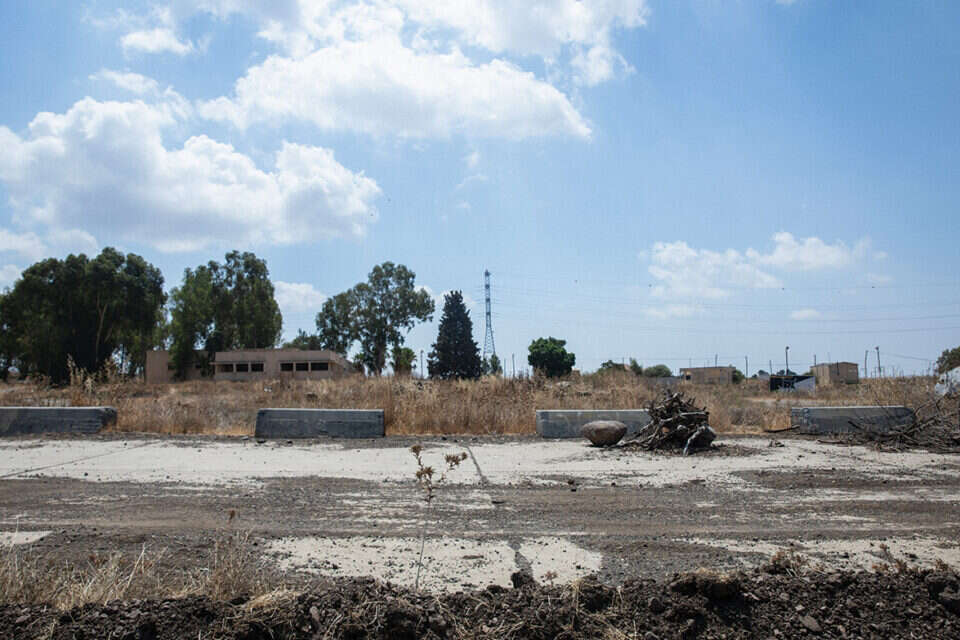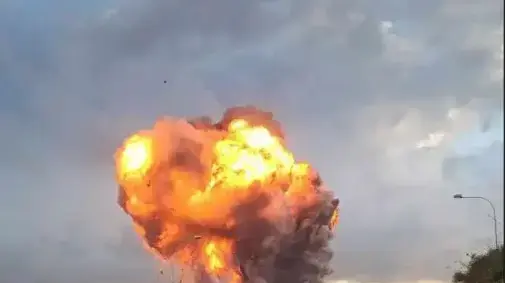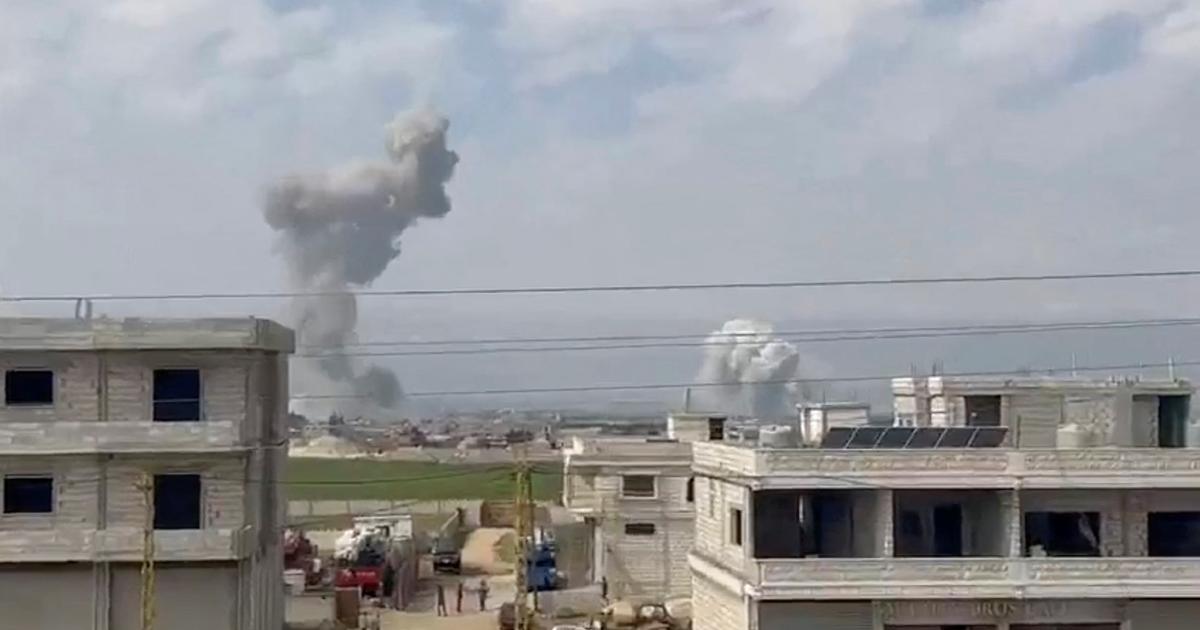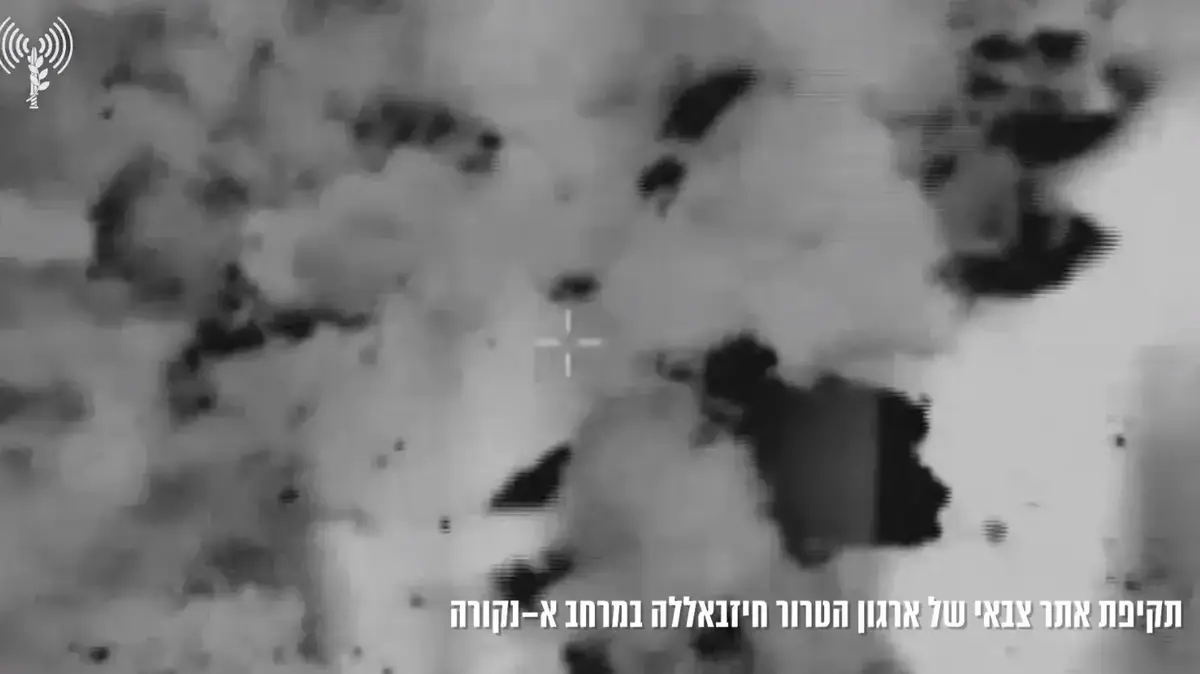The western entrance gate of the Gadot camp is made of a low and dense mesh.
At the top of the gate, on rusty barbed wire, Israeli flags are wrapped in cloth.
They are unraveled and yellowed, and in the heat of August they look as if they were welded to an iron.
A fall of eucalyptus and pine leaves protrudes from the pulp at the foot of the gate: empty bottles, bags of snacks and woolen threads.
The gate is closed by a chain and a lock, but about ten meters to our right the fence is broken.
It takes no more than a slight jump to step inside the camp, towards a large, opaque, enigmatic square hall, and to an elongated structure, a kind of train of rooms, used for the soldiers' quarters and today its windows and doors are displaced.
The silence in the empty parade ground is captivating.
Except for the roar of a truck passing by at the Mishmar HaYarden junction, or the cry of a raven at an unexpected moment, only the hamsin is buzzing in the ears.
An eclectic jungle compacted in an acre or two.
The entrance to the bunker in the Gadot camp / Photo: Lior Tamim,
This is the first stop on a journey between abandoned IDF bases in the Golan Heights - not the mythological outposts of the Yom Kippur War, which were eventually turned into media monuments, but the permanent camps and front bases that have housed thousands of soldiers for decades, and now stand empty of people. And lively towns.They are now portrayed as an impressive theatrical testimony to abandonment.
Some of them were completely destroyed and only waves of ruins and debris remained, which at a glance look like dramatic sculptures. Others, recently evacuated camps, still stand on their emptied structures, with no human movement, with not even a hint of a trace of happening. These structures are subject to the tangle of vegetation, the wandering and nesting of animals, nomads and strays. They are left to the mercy of the passing of time, and may stand for many years to come.
From the Gadot camp, an abandoned military police station near the mountainous Jordan and the Banot Yaakov bridge, we went to prominent points along the terrain: the Nahal Golan outpost, across the perimeter fence on the Syrian border, where there are still several soldiers on duty; Tomato Camp, on the ruins of the Syrian village of Nafah, which served as the UN liaison unit and was evacuated in 2003; Post 116, north of Tel Saki, where the Nahal 50th Battalion of the Nahal sat and would be a memorial site; Post 103, at the end of the Druze town of Majdal Shams, which overlooks the Hezbollah post and is still connected to electricity and water, but is no longer manned by soldiers.
And more: a wall camp, which for many years was home to the 605th Battalion of Combat Engineering, and now its vast area, tens of square miles, conjures up a city that was hastily abandoned in the face of an impending disaster;
And the Thunder Camp, by Egged Artillery 219, which bulldozers boarded a few months ago and piled up rubble.
We set out on a two-day filmed stroll, on a journey of contemplation and wandering in an attempt to capture ongoing transformations.
Not only on earth but also in the consciousness of the place.
Under the scorching sun, among dry deer, dirt roads in tufts and cracked concrete paths, but also in the comfort of cedar shadows.
Here and there we encountered people in the endless expanses of the Golan, but they were just standing in a show titled Silence, or Perhaps Silence.
We looked for a mood.
A classified presence tilted the spoon in the direction of bulldozer destruction.
Ruins in the Thunder Camp, Lior Tamim
Hollow spaces
At each station we visited, the gaze wandered from the buildings on the surface to the depths of the earth.
From the roofs, concrete stairs, walls, asbestos boards, water pipes and electrical wires - to the cracked stone and plaster crumbs.
The direct sights were mixed with more subtle, also abstract, and, of course, drawings of the soul that wandered as a trail following the gaze.
And these were mixed with musty and sweet odors of rust and mold, and odors of hollow wood that rose from the high fields of thorns.
At almost every station: feelings of filth, blurring, crushing and decay.
Sometimes the dirt becomes rough in the hand during evacuation, and its faded color becomes a dark, intense brown.
And at every step, places — above ground, open, closed, underground — impoverished by bustle and movement, stillness, hollow spaces.
From time to time a sudden sway breaks the silence, like a bat flight we have frightened in the depths of a dim bunker.
The lack of bases and camps reveals a pathetic story that evokes imaginative literary cruises: for example, faded postcards from rock festivals from the 1990s still densely adorn the walls of what used to be a living room in the Gadot camp - who lived here?
Where did their musical taste go?
In the empty synagogue and holy books in the wall camp, cloth curtains are revealed - only once in a journey - that are entertained by the wind.
The curtains are transparent, faded, filthy.
The bulletin board with prayer times is empty.
The rock music that disappears from "Gadot" is rolled in a modest prayer that is not heard.
Perpetual air corridor from the direction of the Jordan River.
Gadot Camp, Lior Tamim
There are many abandoned buildings in Israel that give occasional visitors a double impression of grandeur and horror. But the drama at the bases and in the empty camps in the Golan is completely different. Mainly because they revolve around wild and wilderness areas, and next to them are scattered fairly fresh war scars. But if one looks from the bird's eye view at the entire plateau, it is possible that in the abandoned camps in the Golan there is a significant proposal, a message about temporality, fragility and identity. And this is not a pessimistic message. Beyond the here and now, beyond the natural melancholy that the empty bases inflict on the soul wandering in them, they may mark a historic turn in the Golan Heights - from a war zone to a civilian space.
There is still a long way to go.
The state now wants to allocate NIS 250 million for the development of settlement in the Golan Heights, and the request was also included in the state budget.
But the national treatment of the Golan as a temporary deposit, as a space in which the permanent civilian settlements are also used, more or less, positioned in an ongoing campaign, is not subject to government decisions.
It is a state of mind that is nourished by the trauma of the war folded in Israeli existence as a whole.
To change it is not enough to change the surface.
The tactical measures replaced the guards with positions.
An abandoned position at post 103 at the end of Majdal Shams, Lior Tamim
Dry economy
Many military camps in Israel have been evacuated since the beginning of the 21st century by decision of the General Staff, as part of a multi-year process. Infrastructure; if we will: the opening shot. Suitable for the dynamic, chaotic challenges facing combat units. The camps, which over the years resembled small communes with unique jargon, nostalgia and mythology, were not intended to fulfill emergency roles in war, but were used by the units to function routinely. And there is no routine.
The dry economic calculation has cut off traditions. Hm"kim decreasing. The data are confidential, but not excessive estimate that hundreds of them have been evacuated over the past decade. Battalions Other battalions were attached independent, sometimes even divisions, expansive camps, where construction standards improved and better living conditions.
Evacuating old bases is therefore the result of an orderly process However, the performance on the ground, in the test of time, may give a partisan impression - not a complete evacuation, but an abandonment doubt, almost deportation. The State, to the Israel Land Authority. But the Golan Heights land is not a sought-after real estate.
When the IDF evacuates bases in the center of the country, a business opportunity is born. Entrepreneurs stand in line to pay the IDF for the vacated real estate. Thousands of its Jewish inhabitants, it ranges from stagnation to temporality. It has no permanence, at most - static. The changes are almost imperceptible - tiny seismographic shifts. Man - always felt.And in the Golan, a change of this magnitude is like an earthquake.
Plenty of evidence for the social life that prevailed at the bases.
Gadot Camp,
Memory structures
Only window openings and doors remained in the row of soldiers' rooms in the Gadot camp. Each room is a corridor visible to the wind that blows from the nearby Jordan River, emerges from the window key and caresses the face for a moment. The wind should lighten the heat a little.
The barracks building is made of light Templar stone, a relic of the Old Jordan Guard, a colony founded by the first aliyah in Elul 1890. Difficulty and disease passed over the land and its people: during World War I a bloody battle broke out in the area between the British and the Ottomans; in the 1920s Malaria has suffered casualties among the pioneers, and since the 1930s, for two decades, the colony has suffered harassment by Arab rioters. Settled in the ruins of the colony, on the mother of the road, coming to the Banot Yaakov Bridge and crossing the Syrian border.
The evacuation of the base, about a decade ago, was carried out according to the IDF protocol: fast and without sentiments. This residential train remains, a cheap and efficient architectural product of pioneer houses, intended for preservation. But in the spaces there is plenty of evidence for the social life that prevailed in the place: postcards, remnants of posters, slogans, wall illustrations, handprints dipped in black oil and attached to the wall, for decoration. .
Framed press clippings and a new, abandoned monument in front of the parade ground.
The memorial room for Uri Ilan in the Gadot camp, Lior Tamim
Wandering is slow, groping not without fear. The end - in the last room - with a punch in the stomach. The body of Uri Ilan, a Golani fighter who fell into Syrian captivity with four of his friends, was brought here. Ilan was captured and in January 1955 committed suicide. His friends were released. Ten notes were found on his body, which was brought from Damascus. In a famous one of them, which was customary to tell about him in schools, Ilan wrote: "I did not betray. I committed suicide."
It is a dark, rectangular and narrow space. It inspires a surprising inner peace, as if Uri Ilan's mythological heroic story overcomes the emptiness in the room. Alterman wrote: "From the northern border, from the bridge, brought / laid down - on his back and calm as law / who is the next? This is one of the boys of the army / Zah."
Over the years, the room was converted into a commemorative corner: framed press clippings hung on the walls, and Ilan's beautiful portrait was placed next to the right jamb. The portrait is still there, exposed to all without guarding and maintenance. So is the large, fairly new rock monument, which lies in front of the building. It was donated in 2016 "by the people of Israel", the wording on the back. The Gadot camp is supposed to become an information center on the old Jordan Guard, but except for the large, renovated and locked square structure, and some red marking wires, some of them loose and torn, no one seems to have been here long.
Compared to Gadot, a remnant of a camp that has undergone incarnations over a hundred years, Homa Camp, further down Route 91, is a modern site with a presence, whose wandering evokes fear and distress.
The feeling is that this is a disaster area.
Three years ago, the 605th Battalion of the Combat Engineering evacuated it. Today, the camp gate is open. Because new, "wrote a kosher supervisor on the sign, and unknowingly provided a metaphor for the future of the place.
"It's a little crazy the other side, not knowing when we're there or not."
On the roof of post 116, Lior Tamim
605 is a rift and successful battalion. Its fighters participated in the best engineering maneuvers of the army - from the success of the canal in Operation "Knights of the Heart" in October 1973 until the battle of Wadi Salouki in the Second Lebanon War. The battalion is equipped with excavators and heavy engineering tools, and even now, after leaving the "wall", two formidable D-9s, four meters high and four meters high, are parked under the shed of the workshop. Sometimes the tool operators come here to use the area for ranges For guest units, but there is usually no living soul here. The D-9 cannot be locked like a private vehicle, any engineering fighter knows that. A ride on the monster?
The residential buildings, the Knesset and the trio are spread out in the area. We wander around the place on a hot afternoon, lingering in the shade of a carob tree to regulate our breathing. To the camp, rumor has it that a pre-military preparatory school, currently located at the Trump level, will be inhabited.
It is difficult to continue touring the abandoned camp. The feeling is that we have seen only a little of it, but suffocation stands in the throat. We leave the place almost in a hurry, and retire - what a relief - for lunch at the headquarters of the spatial division in a volume camp. When we arrive, men and women are flocking to the dining room. The corona requires controlled entry: an epidemic time, albeit an exceptional one, but a routine one, without the slightest hint of drama. Typical IDF casting. Fences, a small artificial grass plot, paths free of weeds, and on the walls detailed notices, scrolls, appropriate clothing, warnings about the use of narcotics, etc. The mirrors sharpen the gap between the bustling, vital volume camp and the spaces. The empty ones in the wall camp, which were left on the side of the road as waste destined for fire.The comparison is inevitable: similarly, we must see a "wall" in better times.
A military camp empty of a man from the tell.
He finds from his original context.
When it is active and full of life, the presence of soldiers and officers fulfills the purpose of its existence.
His destiny cannot be mistaken.
But after the uniformed men disappear, with the buildings standing still and exposed to the ravages of time, all of a sudden the camp seems like a desolate, haunted settlement, a site where working, social and family life operated and felt,
In "Wall", as in other bases we have seen, the monotonous unity of emptiness emphasizes what transcends it, milestones for reconstructing the past, which are like dead letters: for example, a piece of paper with a name thrown in a corner, an empty bulletin board, an orphaned table, and a chair. Stupid Hollywood, leaning on his side with only three legs.
Some of the evacuated bases are empty even of this, and they, absurdly, have become a monument of their own.
Such is the camp of thunder, which was completely destroyed. To get there from the "wall" drive a few minutes in a westerly direction, pass the upper customs house, which has been renovated and converted into a luxury hotel, and pass by the Ein Ampi and Ein Alamein springs (officers' pool). Here, among palm trees, eucalyptus and tall, playful oaks, in bright or pastel shades of green, sat Egged Artillery 219 with MLRS launchers.
The classified presence of powerful tactical weapons may have tipped the scales in favor of bulldozer destruction. And destruction, every Bezalel student knows, is very intriguing and even beautiful in its own way. Now the destruction of the place is being photographed as an art installation carefully erected in a large-scale museum - a mosaic of ruins. We move quickly between mountains of large concrete blocks and long, curved iron bars in a variety of shapes. Everything is gray, gray.
In the south of the ruined compound of "Thunder", a guard tower from Eretz Israel is still standing. He also tells a story about the ephemerality of the ongoing security in this land. In online search engines you can casually find watchtowers around the world of all kinds and shapes: a red brick spire in Albania, a potted tile tower in the state of Baden-Württemberg in Germany, a serrated and armored spire in Avignon in France.
None of them resembles the Eretz Israel tower, which is also, apparently, not Israeli.
It is a rather dilapidated tower in the shape of an octagon, made of wood and metal, with four slender legs and a fixed ladder on its side.
Windows on all sides and a spotlight on its roof, it is designed to provide security to the guards and occupants of the bases.
In Israeli prisons, as well as along the separation wall and other sensitive areas, this old-fashioned tower has been replaced with a concrete-molded pillbox, but in most permanent camps it still stands in silence at the edge.
And there is always the bunker.
It, the non-ruined one, resembles a strange Inca-style temple, whether designed in symmetry or hurriedly tossed like a wave of heavy stones.
It is the only structure in the camps and bases that provided a real shield, and the only one we experienced as an unpleasant playground, a kind of city of demons combined with the wall of death.
The bunker is made mostly of natural material from the area, durable and cheap - basalt stone.
The dark and black heat of the bunker, opposite the white and yellow of the ordinary, temporary structure, which sooner or later will be evacuated or destroyed.
A mural in the Gadot camp, Lior Tamim
Nature awakens
The road from Mahnayim junction to Gadot camp is littered with cypresses and agricultural fields, but when you stand in front of the camp, just before the sharp turn down to the Jordan, you discover an eclectic jungle compacted in an acre or two: pines, eucalyptus, Eshel trees and bougainvillea bushes, hedgehogs, elm, snipers.
It seems that the camp sergeant was an avid botanist - 2,000 species of sabra bushes were born and the Gadot camp took a thousand of them. dry.
The animals are the construction workers left after the place emptied.
Gradually, they help nature regain control of the territory that has been stolen from it.
As in the beginning of the Corona plague, when wild animals came out of the woods and were suddenly seen wandering the city centers and empty highways, so in the battalion, which was emptied of its contents, you will not be surprised to find a common badger.
At post 116, not far from Tel Saki, we opened the door of a car warehouse, seemingly closed for a long time, and a white soul spread its wings over us in slow flight.
Near the thunder camp we were enchanted by a wild gray horse galloping merrily alongside the remains of the fence.
From the bushes surrounding the skeletal structure of the walled camp, an average-sized Syrian rock rabbit leapt toward us, disappearing hopping behind the mound leading to the road. outside.
Wasps, dragonflies, lizards, spiders, scorpions, snakes, nymph butterflies and flutes - these are the quiet, trampled, hidden guests in these spaces.
They mock the remnants left by the camp occupants, ignoring the ephemerality of the hostel.
Wasp nests cling to the lintels of the rooms.
Lizard droppings are scattered like crumbs on the floor.
Next to a fairly modern briefing room we heard squeaky animal movements.
We were afraid to come in and check out Mina.
At the Nahal Golan outpost, the embossed bunker canals leading to the observation post - from which the Rokad stream unfolds in all its glory - are almost completely blocked by a thickened tangle of leaves, shrubs and thorns.
The effort pays off: when you reach the high stage, the view is breathtaking, even if the merging point between the Rockad and Yarmouk is too far for the naked eye.
A building decorated with an inscription - "Golan Castle" - is almost the only remnant of a tomato camp.
It most likely served as the operational liaison of the UN liaison unit, which today is attached to the brigade headquarters.
It is a colorful and intriguing Syrian structure, with a triangular stone roof enclosing it, and in front of it a horizontal row of black bricks.
It conjures up a customs position or a border control station.
It is easy to imagine an official sitting inside and signing visas.
For most of the day he is sheltered in the shade of pines.
The people of the mountain
We spend the night between the days of wandering in Nimrod, at the foot of Mount Hermon, in the wooden hut of Major General (Res.) Gershon HaCohen, above the clouds. The kiln of the daytime hours has been replaced by a thick, cool fog that conquers the darkness. Gershon built the hut with his own hands, outside the fence of the settlement that was one of its founders. Now, in the mists that surround her, she seems to be floating in the air.
Like the tent of our ancestor Abraham, Gershon's house is not only a guest for passers-by, but a meeting point for the exchange of information and opinion. Gershon is welcoming, and instead of Avraham's "Three Saim Flour" he hurries to bring fresh vegetables to a salad and pulls out a bottle of well-preserved red wine - Otzar Beit Din. The wine warms the body against the cool wind that blows in Nimrod even in summer.
At the entrance to the hut hangs a 1921 photograph of his grandfather, Nathan Gerdy, and his pioneering friends in wheat horns. Everyone has guns. "There is no plowing without weapons," he remarks. There is a price for settlement and assimilation. In our ongoing conversation into the night, Gershon speaks with concern about the impression that the Golan is a district of ephemerality, and how he is portrayed in the eyes of his natives, the Druze, his good neighbors with whom he shares a common language and love for the land and creatures living on it. He keeps food for wolves and horses, and before going to bed makes it clear that if we hear noises from the attic it is the fire, a wild weasel that gnaws at the insulation.
In the morning, Dolan Abu Salah, head of the Majdal Shams Council, arrives at Cafe Dolan.
His young looks are attractive, and deceptive - he has been in the job for more than a decade.
Is he pleased that the IDF has abandoned Post 103, at the summit of its village? Emotions are mixed. On the one hand, no one likes firing positions and soldiers behind the house. On the other hand, the presence of the army has become routine. The military is a shaker accompanied by uncertainty, and the term "temporality" also emerges in this conversation.
Dolan cares for the people of the town for whose well-being he is responsible, even though only a small percentage of its residents voted for him.
Most Majdal Shams hold residency rather than Israeli citizenship, and do not cooperate in a symbolic act such as voting at the ballot box.
Dolan wants to take care of everyone, and worrying means budgets.
Officials in Jerusalem, as usual, want more and more master plans and pile up bureaucratic difficulties.
Ignorance, institutional bumps - that's the essence of temporality in Dolan's eyes.
When Dolan leaves, we go out with Gershon.
He had just finished planting Elul, before disabling the year of omitting the herdsmen.
Gershon shows us the cherry and strawberry trees he planted with the help of an assistant from Majdal Shams, on three terraces overlooking the Nimrod plaza.
The Crusader fortress, built in the 12th century, survived the Ayyubids, Mongols, Mamluks, Ottomans.
Even today it is a spectacular and powerful sign.
Although the settlement of Nimrod dominates it from above, it seems that the fortress is still grinning at it.
Mark Twain wrote of him on his travels in the country: "So ancient that no one knows when it was built and by whom."
He is not disturbed by the winds constantly beating him or by the human desire to wander on.
Abandonment in the mirror mirror
The outgoing Chief of Staff of the Northern Command, Yoram Knafo, wants to explain in a phone call why what looks like abandonment is not abandonment. This is especially true for outposts, most of which are located on the perimeter fence. "Unlike the permanent camps that later become civilian territory, an outpost, even if it is empty, remains under the responsibility of the IDF," he says. It can be a post intended for war only, or a post from the worlds of ongoing security and border protection. It creates uncertainty for the other side, which does not know when we are there and when not. "
A modern cat and mouse game. A cheap, predictable, but effective trick. At 103, a tiny outpost at the high end of Majdal Shams, with one living pavilion and countless antennas, we reached between the suns. Of the fighters in the embossed positions, overlooking Syrian territory, only engraved inscriptions remain, including a variety of versions of the iconic motto "Broken Z **". The soldiers were replaced by the "static means" - sophisticated radars. They make a slight buzz and look 24/7 at the amphitheater facing opposite, 250 meters away. Behind the amphitheater - the border is a setting for a long bloody play that is far from over - Hezbollah's position.
Returning the land to civilian hands requires, Knafo clarifies, "meeting three conditions - a scan of the information security squad to make sure no documents or classified infrastructure remain; a scan of engineering forces, checking that there are no explosives or ammunition that could harm hikers or passers-by;" "Israeli land, which indicates which buildings the army must evacuate and which buildings we must leave. What are we leaving? Mainly buildings from the world of conservation, such as a tomato camp from the Syrian period, or those with an artistic or architectural 'section' that may be used by the locals."
The whole Torah is on one foot. But in practice the process sometimes takes years. Thus a gray time is created, in which the abandoned camp is abandoned to the grace of nature. If you will: The no man's land in the desert is deserted. It is an ugly time, torn between intentions and desires, an oppressive time of idleness, weathering, kidney, and sometimes this time is irreversible. After all, morning news changes programs and budgets are shifted to other purposes.
His wing is not exactly satisfied with the situation. "There is an interest in reducing the permanent camps that the IDF has left and disappearing them if they are not used," he says.
Until he succeeds in realizing his intentions, his heart will continue to shrink at the sight of the empty space.
"I was a battalion commander of the Thunder Battalion, I grew up in this camp and we invested a lot in it.
Sometimes I walk around there and tell the driver to slow down the car, bring up memories.
I remember the beret trips, the departure and return to the camp during the Second Lebanon War, where my children were when they came to visit me during Shabbat on duty. "
We arrived at the Nahal Golan outpost, where we ended our journey, as an uninvited guest at a family event.
The base itself is no longer active, but the evacuation has not been completed, and will probably not be completed in the foreseeable future.
The staff left here are sleepy, his tasks minimal.
The SAG was intrigued by our arrival at the place and eager to be photographed. He walked slowly by the gate, prepared himself for the photo, took his time.
The armor tools are parked in perfect order, aligned to the millimeter. The evacuation process here is caught in the middle, perhaps stuck. The vehicles are maintained and polished, like dozens of counters of toy toys, but only three or four soldiers are here, as if left behind. No kitchen. The dishes are brought from a nearby base. The view is spectacular and breathtaking, perhaps the most beautiful we have seen, but the silence is unsettling. Until a discovery was made in the briefing room donated by an American philanthropist: 20 soldiers of a classified unit were resting on the floor, the equipment spread out beside them. They passed there like nomads sleeping under a crumbling roof of an abandoned guy. As expected, they are smiling and kind, but do not provide information about who they are and what they are doing here.
Thus, from the rusty gate and the silence of the living rooms in most of the camps we visited - to the partial evacuation, passers-by and the primeval landscape of the Golan camp; From the rear camp, the headquarters that kisses the slopes of the plateau - to the tense front post, which overlooks Syrian towns and villages. The Golan Heights is in the midst of a feature, albeit slow, but dramatic. How will these many places, empty and empty, affect her? Early to know. One can only recall a slight smile on the sign that the regional council hung on the entrance gate to the Gadot camp: "A race following Rishonim, on behalf of the Heritage, Society and Nature College."









